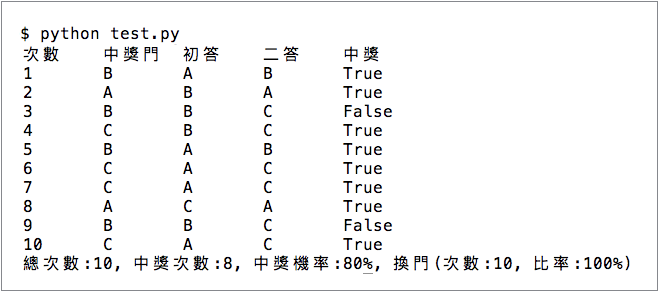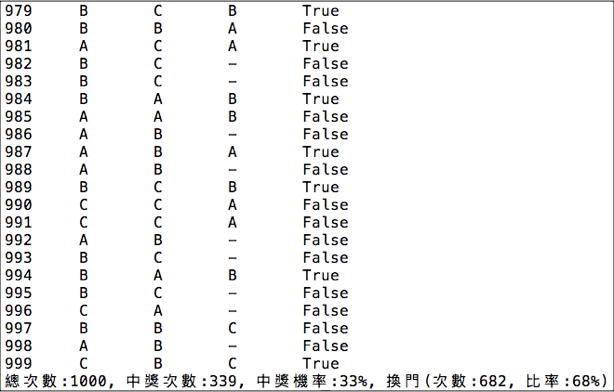蒙提霍爾問題¶
蒙提霍爾問題(Monty Hall problem )來自於一個贈獎遊戲,主持人蒙提霍爾有三個門讓你選,其中一個門後面是汽車,另兩扇門是摃龜門,你選中那扇汽車門,門後汽車就是你的。你選定之後,主持人會開啟另外兩扇門當中的一扇摃龜門,剩下你選的那一個跟另一個可能是汽車也可能是摃龜的門,這時候,你可以決定是否要更換選擇。主持人可能會誘導你選擇摃龜那一扇,也可能不會。問題是,換門或不換哪一個比較好?
我是在實作數學輕鬆聚的臉書社團上讀到這個問題的,這問題也稱為「三門問題」。這個問題有趣的地方是,它違反直覺。直覺上,一開始三個門後是汽車的機率都是1/3,主持人開啟一個門之後,剩下兩扇門後的機率變成是1/2。換不換門應該不影響中獎機率,但是,實際上,你沒選中的那扇門後是汽車的機率竟然是2/3,也就是說,換門會更可能中獎。這表示你一開始不論是猜哪一扇門,都是比較爛的選擇,怎麼會這樣?
科學Online高瞻自然科學教學平台上這篇「蒙提霍爾問題(一)決勝21點」文章內有詳細的說明,用機率說明為什麼換門會更好,以數學來講,這是條件機率的緣故。
模擬¶
可是,我覺得這件事情還沒有結束,因為我認為數學是用來輔助「理解」的工具,它不算「理解」。如果不知道錯在哪裡,只是把答案死背下來而已,不是真的理解。這種死背的假知識在下回應用的時候可能反而做出錯誤的判斷。我想要繼續追究的問題是,到底直覺錯在哪裡?一開始,我覺得自己是缺乏「條件機率」的直覺,反覆觀看整個證明過程,嘗試建立「條件機率」的直覺。然而,總是覺得對於「條件機率」的直覺依然不能成功的建立起來。後來,我決定寫一段Python程式,嘗試模擬遊戲的整個過程。
1 2 3 4 5 6 7 8 9 10 11 12 13 14 15 16 17 18 19 20 21 22 23 24 25 26 27 28 29 30 31 32 33 34 35 36 37 38 39 40 41 42 43 44 45 46 47 48 49 50 51 52 53 54 55 56 57 58 59 60 61 62 63 64 65 66 67 68 69 70 71 72 | #! -*- coding:utf-8 -*-
# test.py
#
# Simulation of "Monty Hall problem"
# See http://highscope.ch.ntu.edu.tw/wordpress/?p=47158 for details.
#
# By Iap, Singuan (Feb 12, 2017)
#
# Copyright © 2017, BSD License (我同意你想怎麼用就怎麼用,不必再問我)
#
import random
class Question(object):
options = ['A','B','C']
def __init__(self,idx):
self.idx = idx
self.answer = self.options[random.randint(0,len(self.options)-1)]
self.choice = ''
self.originChoice = ''
self.openedOption = ''
self.win = None
def choose(self,c):
self.choice = c
self.originChoice = c
def openDoor(self):
options = self.options[:]
options.remove(self.answer)
if self.answer != self.choice:
options.remove(self.choice)
self.openedOption = options[random.randint(0,len(options)-1)]
def switchChoice(self):
options = self.options[:]
options.remove(self.choice)
options.remove(self.openedOption)
self.choice = options[random.randint(0,len(options)-1)]
def finish(self):
self.win = self.choice == self.answer
def generateQueustion(n=10):
questions = []
for i in range(n):
questions.append(Question(i))
return questions
def main():
options = Question.options
n = 10
questions = generateQueustion(n)
winCount = 0
switchCount = 0
optionsLength = len(options)
for question in questions:
question.choose(options[random.randint(0,len(options)-1)])
question.openDoor()
#if random.randint(0,1)==0: ## 換不換門的機率一半一半
if random.randint(0,1)<optionsLength: ## 一定換門
#if random.randint(0,1)>optionsLength: ## 一定不換門
question.switchChoice()
switchCount += 1
question.finish()
if question.win: winCount += 1
lines = ['\t'.join(('次數','中獎門','初次選擇','最終選擇','中獎與否'))]
for question in questions:
line = [question.idx,question.answer, question.originChoice, question.choice, question.win]
lines.append('\t'.join(map(lambda x: str(x),line)))
switchPercent = int(100*float(switchCount)/len(questions))
lines.append('總次數:%s, 中獎次數:%s, 中獎機率:%s%%, 換門(次數:%s, 比率:%s%%)' % (len(questions),winCount,int(100*float(winCount)/len(questions)), switchCount, switchPercent))
print '\n'.join(lines)
if __name__ == '__main__':
main()
|
(這段程式看不懂沒關係,放在這裡只是讓有興趣的人可以複製去玩一玩而已)
執行結果如下圖:
在程式的54-56行,可以切換不同的策略。執行幾次之後,的確顯示出換門是比較好的策略。但是,這不是重點,因為在機率計算下,本來就應該這樣,如果不是的話,是程式有BUG。這也不是「用程式證明了數學推導」畢竟用的只是尋常的random函式而已,不是嚴格的模擬。
直覺錯在哪裡¶
寫程式模擬的過程強迫我必須深入每一個過程的細節,在這一過程中,我領悟出為什麼我的直覺會出錯。我發現出錯的關鍵在於我沒有考慮到「主持人決定開哪一扇門」這個行為所造成的影響,一直到我寫到主持人開門的這一段程式。請看程式中第25行附近的 openDoor 子函數。
def openDoor(self):
options = self.options[:]
options.remove(self.answer) #不能開中獎門
if self.answer != self.choice: #不能開你已選擇的那個門
options.remove(self.choice)#移除此門之後,只剩下一個門可以開
self.openedOption = options[random.randint(0,len(options)-1)]
當主持人選擇要開啟哪一扇摃龜門的時候,其實他的選擇很有限,首先,不能是你選的那一個,其次,不能是中獎的那一個。他開門遵守「一定不能開中獎門」規則的行為,也受到你選擇的是哪一扇門的影響,這些限制條件,為此系統注入一個明確的資訊使得「他不開的那一個是汽車」的可能性大增。
驗證方式¶
我的直覺會錯誤原因在於我只是從自己的觀點作純機率的考量,沒有將主持人的行為納入考量。但是,這一推測也只是「直覺」,怎麼確定是對的呢?我檢驗的方式是:把限制主持人開門的規則拿掉,也就是說,假設主持人不知道哪一扇門後是汽車,他從遊戲者挑剩的兩扇門中隨機開啟其中的一扇門,如果開出汽車則遊戲結束,如果不是,則遊戲者可以選擇換門或不換門。修改遊戲規則之後的模擬程式碼如下:
1 2 3 4 5 6 7 8 9 10 11 12 13 14 15 16 17 18 19 20 21 22 23 24 25 26 27 28 29 30 31 32 33 34 35 36 37 38 39 40 41 42 43 44 45 46 47 48 49 50 51 52 53 54 55 56 57 58 59 60 61 62 63 64 65 66 67 68 69 70 71 72 73 74 75 | #! -*- coding:utf-8 -*-
#
# Simulation of "Monty Hall problem" (Door opened blindly)
#
# By Iap, Singuan (Feb 12, 2017)
#
# Copyright © 2017, BSD License (我同意你想怎麼用就怎麼用,不必再問我)
#
import random
class Question(object):
options = ['A','B','C']
def __init__(self,idx):
self.idx = idx
self.answer = self.options[random.randint(0,len(self.options)-1)]
self.choice = ''
self.originChoice = ''
self.openedOption = ''
self.win = None
def choose(self,c):
self.choice = c
self.originChoice = c
def openDoorBlindly(self):
options = self.options[:]
options.remove(self.choice)
self.openedOption = options[random.randint(0,len(options)-1)]
if self.openedOption == self.answer:
self.win = False
return True
def switchChoice(self):
options = self.options[:]
options.remove(self.choice)
options.remove(self.openedOption)
self.choice = options[random.randint(0,len(options)-1)]
def finish(self):
self.win = self.choice == self.answer
def generateQueustion(n=10):
questions = []
for i in range(n):
questions.append(Question(i))
return questions
def main():
options = Question.options
n = 1000
questions = generateQueustion(n)
winCount = 0
switchCount = 0
optionsLength = len(options)
for question in questions:
question.choose(options[random.randint(0,len(options)-1)])
if question.openDoorBlindly():
# 已經被主持人抽中,遊戲結束
question.choice = None
continue
#if random.randint(0,1)==0: ## 換不換門的機率一半一半
if random.randint(0,1)<optionsLength: ## 一定換門
#if random.randint(0,1)>optionsLength: ## 一定不換門
question.switchChoice()
switchCount += 1
question.finish()
if question.win: winCount += 1
lines = ['\t'.join(('次數','中獎門','初次選擇','最終選擇','中獎與否'))]
for question in questions:
line = [question.idx,question.answer, question.originChoice, question.choice or '-', question.win]
lines.append('\t'.join(map(lambda x: str(x),line)))
switchPercent = int(100*float(switchCount)/len(questions))
lines.append('總次數:%s, 中獎次數:%s, 中獎機率:%s%%, 換門(次數:%s, 比率:%s%%)' % (len(questions),winCount,int(100*float(winCount)/len(questions)), switchCount, switchPercent))
print '\n'.join(lines)
if __name__ == '__main__':
main()
|
(這段程式看不懂沒關係,放在這裡只是讓有興趣的人可以複製去玩一玩而已)
執行結果如下圖:
其中第四欄位是 dash “-” 表示該次提早結束。我測試了三種策略(換、不換、隨機換),模擬結果都是一樣的,中獎機率都是33%,跟瞎猜一樣。
結論¶
在原本的遊戲規則中,主持人的行為提升了最後那扇門後面是汽車的機率,使得換門成為一個比較好的選擇。我們一開始瞎猜的選擇並沒有比較差,而是後來出現了更好的選擇,這是換門會更好的原因。直覺的錯誤是因為直覺沒有察覺到出現了更好的選擇。
或者,換一個觀點來看,在決定是否換門的當下,這兩次的選擇是在不同的情境,第一次選擇時,汽車是隨機出現在三個門當中。然而,第二次選擇時,汽車不是隨機出現在兩個門,汽車「被安置」在最後剩餘的那一個門的機會是⅔. 有意思的地方是,「隨機」竟然不是絕對的,當某一個知道秘密的人做出某種行為時,原本的隨機性竟然改變了。
「主持人知道門後的秘密,刻意避開開啟中獎那扇門的行為,反而提高了他沒開的那扇門的中獎機率」這件事情好像是違反一般的直覺,仔細想想,這在日常生活中卻是很常見的,例如國防部對於任何軍事相關的問題一概不承認不否認,因為只要給出某種確定性便會改變某些其他事情的機率,如果要隱藏某些資訊,所謂虛虛實實,實實虛虛,才是好的策略,這道理孫子兵法早有闡述,歷史上的實例可就不勝枚舉了。
我們做出選擇之後,應該注意是否出現了新的情勢,使得當初放棄的選項已經成為更好的選項,尤其是自己以外的其他關係人的行為。當系統中有知情的行動者做出某一特定的行為時(譬如創辦人出脫持股),他的行為可能改變了我們在某些選項上的勝率。
Caution
話說回來,我們必須記住「可能性永遠只是可能性」,千萬不能把「最可能」與「事實」相混淆,很多冤案就是這麼來的。

